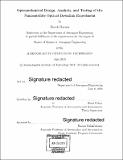| dc.contributor.advisor | Kerri Cahoy. | en_US |
| dc.contributor.author | Barnes, Derek (Derek Christine) | en_US |
| dc.contributor.other | Massachusetts Institute of Technology. Department of Aeronautics and Astronautics. | en_US |
| dc.date.accessioned | 2018-11-15T16:34:46Z | |
| dc.date.available | 2018-11-15T16:34:46Z | |
| dc.date.copyright | 2018 | en_US |
| dc.date.issued | 2018 | en_US |
| dc.identifier.uri | http://hdl.handle.net/1721.1/119057 | |
| dc.description | Thesis: S.M., Massachusetts Institute of Technology, Department of Aeronautics and Astronautics, 2018. | en_US |
| dc.description | Cataloged from PDF version of thesis. | en_US |
| dc.description | Includes bibliographical references (pages 97-100). | en_US |
| dc.description.abstract | As space payloads are miniaturized, many companies and government agencies are fielding small satellites that can compete with traditional "monolithic" satellites. More than 250 CubeSats were launched into orbit in 2017 alone. As the density of increasingly capable small satellites in orbit increases, many CubeSat operators are finding that current radio frequency (RF) communications are not capable of transmitting the amount of data desired. Free Space Optical (FSO) communication systems offer an alternative to traditional RF systems that can offer data rates more than an order of magnitude faster than RF communication while using less power and mass. This thesis describes the optomechanical design, analysis, and test results of the Nanosatellite Optical Downlink Experiment (NODE). NODE is a CubeSat FSO communication system demonstration mission. The NODE payload is a hosted payload that is designed to establish and maintain optical alignment, survive launch loads, and maintain allowable flight temperatures. Resonant frequency analysis predicts the first resonant frequency to be 500 Hz. Fastener analysis predicts margins of safety greater than 200 for shear, tensile, and separation analysis. Depressurization analysis is performed to calculate expected payload pressure loads and optical bond analysis is performed and predicts a margin of safety of 5 for adhesive optical bonds in a worst-case scenario. Thermal analysis predicts the NODE payload to maintain required operational and survival temperatures in worst all scenarios. Vibration testing of the payload identified the first resonant frequency of the payload to be at 500 Hz. Component level TVAC testing of the Erbium Doped Fiber Amplifier is performed and an optical loss of 0.2 dB is measured. FSM pointing repeatability testing is performed and pointing capability is verified to be within +- 3.6 arc minutes of the commanded location. | en_US |
| dc.description.statementofresponsibility | by Derek Barnes. | en_US |
| dc.format.extent | 100 pages | en_US |
| dc.language.iso | eng | en_US |
| dc.publisher | Massachusetts Institute of Technology | en_US |
| dc.rights | MIT theses are protected by copyright. They may be viewed, downloaded, or printed from this source but further reproduction or distribution in any format is prohibited without written permission. | en_US |
| dc.rights.uri | http://dspace.mit.edu/handle/1721.1/7582 | en_US |
| dc.subject | Aeronautics and Astronautics. | en_US |
| dc.title | Optomechanical design, analysis, and testing of the nanosatellite optical downlink experiment | en_US |
| dc.type | Thesis | en_US |
| dc.description.degree | S.M. | en_US |
| dc.contributor.department | Massachusetts Institute of Technology. Department of Aeronautics and Astronautics | |
| dc.identifier.oclc | 1057725864 | en_US |
